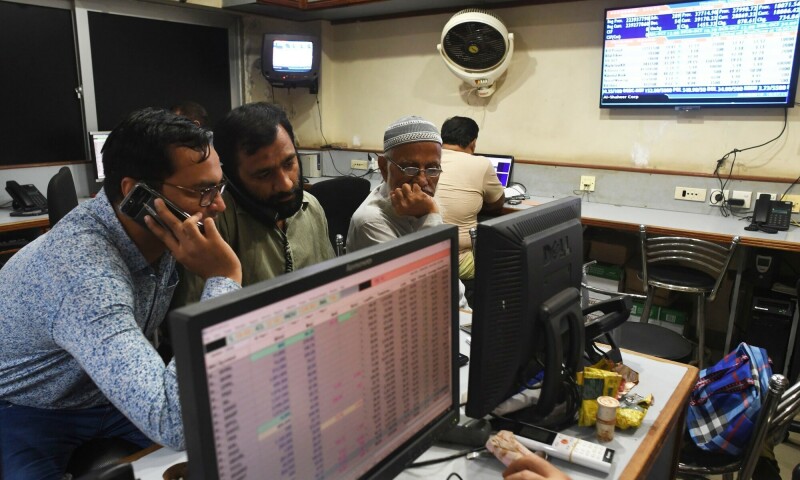KARACHI: Amid escalating tensions between nuclear-armed neighbours following India’s unlawful missile strikes against civilians early Wednesday, which resulted in the deaths of dozens of innocent people, investors grew increasingly concerned that the conflict could escalate into a full-scale war.
Pakistan’s armed forces responded by downing five Indian fighter planes, creating a panic-like situation in the stock market. This led to staggering losses for the benchmark index in the outgoing tumultuous week.
However, with some positive developments, including an interest rate cut and much-anticipated smooth sailing at the International Monetary Fund board meeting approving the second tranche and the climate resilience fund, the market in the last session staged a partial recovery.
Indian drone attacks in major cities, including Karachi and Lahore, on Thursday, caused a bloodbath on the PSX, wiping out almost a trillion rupees from the market capitalisation as the index recorded the largest-ever plunge in absolute terms in a single day, losing nearly 6,500 points amid growing uncertainty about the economic outlook.
According to Topline Securities Ltd, the plunge was largely on account of border hostilities which kept the investors on the edge.
However, Friday’s index recovery of 3,648 points (3.52pc day-on-day) was driven by expectations of approval of a $1bn tranche under the first review of the EFF programme by the IMF’s Executive Board. On the macro front, the central bank reduced benchmark rates by 100bps to 11pc, while worker remittances continued their strong trend, arriving at $3.2bn for April, up 13pc year-on-year.
The benchmark KSE 100 index, which reached an intra-week high of 115,093 points after opening at 114,386, plunged to an intra-week low of 101,599. However, by the end of the week, it managed to close at 107,175, marking a decline of 6,93869 points or 6.08pc.
According to AKD Securities, the market trended negative throughout the week.
Moreover, the budget deficit was recorded at Rs3.0tr in 9MFY25, while the primary balance posted a surplus of Rs3.5tr for the same period. In addition, the IMF’s board has approved the $1.0bn tranche and $1.3bn under its climate facility, called Resilience Sustainability Fund.
The average trading volume rose 20pc to 508m shares week-on-week.
On the forex front, SBP reserves recorded an uptick of $118m to $10.3bn as of May 2.
Other significant developments in the outgoing week included India cutting water supply to Pakistan from Baglihar Dam on Chenab River, cement sales clocked in at 3.34m tonnes, up 8pc year-on-year in April, S&P Global forecasts more rate cuts, and OMC sales increased by 32pc in April.
Sector-wise, vanaspati and allied industries, sugar, and synthetic and rayon were amongst the top performers, up 13.5pc, 5.5pc, and 0.4pc week-on-week. On the other hand, transport, chemical, and refinery reported a decline of 13.9pc, 13.3pc and 11.8pc, respectively.
Flow-wise, barring debt, major net selling was recorded by mutual funds and individuals, with a net sell of $23.6m and $11.3m, respectively.
On the other hand, banks, companies and other organisations absorbed most of the selling with a net purchases of $15.2m, $8.0m and $7.8m, respectively.
Company-wise, top performers were Nestle Pakistan (up 3.1pc), JDWS (3.0pc), IBFL (1.9pc), and Murree Brewery (0.6pc), while top laggards were AGL (23.5pc), The Searle Company (18.8pc), PTC (15.4pc), and PSX (15.3pc) week-on-week.
However, AKD Securities Ltd believed the market overreacted to the ongoing Indo-Pak border tensions as the development of nuclear capability had significantly reduced the likelihood of full-scale war.
The same had been witnessed during escalations since both nations attained nuclear deterrence. The brokerge house expects market to rebound with de-escalation of ongoing geopolitical tensions, alongside approval of inflows from the IMF.
Published in Dawn, May 11th, 2025


